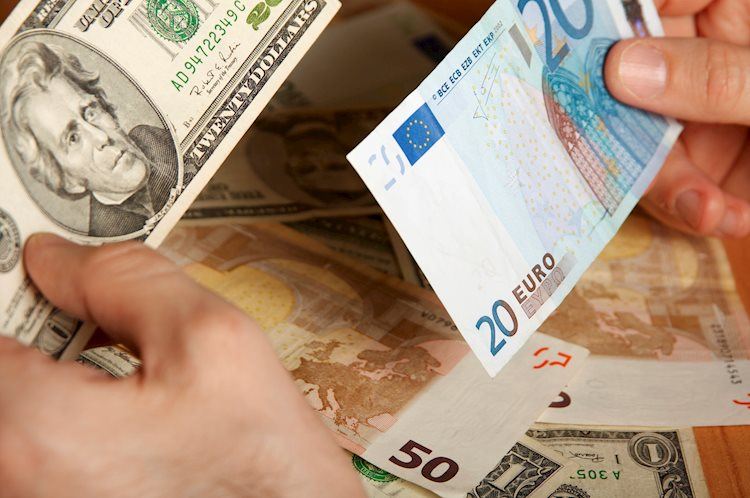- The Euro loses further ground against the US Dollar.
- European stocks trade with decent gains across the board.
- US Factory Orders surprised to the downside in October.
The Euro (EUR) loses further grip against the US Dollar (USD), dragging EUR/USD to retreat to three-week lows around the 1.0820 region at the beginning of the week. This area also coincides with the critical 200-day SMA.
Conversely, the Greenback appears to be enjoying marked buying interest circa 103.70 when gauged by the performance of the US Dollar Index (DXY), managing to flirt with the area of multi-session tops and surpass the key 200-day SMA at the same time.
Considering the broader economic landscape, investors consider potential interest rate reductions by both the Federal Reserve (Fed) and the European Central Bank (ECB) in the spring of 2024.
In the Eurozone docket, Germany’s trade surplus widened to €17.8B in October and the sentix Index, which measures Investors’ Confidence in the euro bloc, improved to -16.8 for the month of December. Later in the session, ECB’s Vice Chair of the Supervisory Board Frank Elderson is also due to speak.
Across the ocean, US Factory Orders contracted at a monthly 3.6% in October.
Daily digest market movers: Euro looks weak and revisits the 200-day SMA
- The EUR starts the week well on the defensive against the USD.
- US yields rebound following Friday’s strong pullback.
- Investors see the Fed reducing its rates in Q2 2024.
- The ECB could start cutting rates in the spring of 2024, according to markets.
- ECB’s Vice President Luis De Guindos reiterated the bank’s data-dependent stance.
- EMU Sentix Index improved a tad to -16.8 in December.
- Lagarde will speak later in the session, around 14:00 GMT.
Technical Analysis: Euro risks a deeper drop below 1.0820
EUR/USD kicks off the new week with a marked retracement and approaches the critical 200-day Simple Moving Average (SMA) at 1.0818.
If the EUR/USD continues to experience further losses, it could potentially face the mentioned 200-day SMA as an initial point of support. In the event of a breach, the 55-day SMA at 1.0682 is likely to provide temporary support. However, if this level is also cleared, it would expose the weekly low of 1.0495 (October 13), followed by the 2023 low of 1.0448 (October 3) and the psychological level of 1.0400.
If there are occasional bullish attempts, they are likely to encounter immediate resistance at the November peak of 1.1017 (November 29). This is followed by the August high of 1.1064 (August 10) and another weekly top of 1.1149 (July 27). These levels act as hurdles before reaching the 2023 peak of 1.1275 (July 18).
The pair is anticipated maintaining its bullish outlook while remaining above the 200-day SMA.
Euro FAQs
The Euro is the currency for the 20 European Union countries that belong to the Eurozone. It is the second most heavily traded currency in the world behind the US Dollar. In 2022, it accounted for 31% of all foreign exchange transactions, with an average daily turnover of over $2.2 trillion a day.
EUR/USD is the most heavily traded currency pair in the world, accounting for an estimated 30% off all transactions, followed by EUR/JPY (4%), EUR/GBP (3%) and EUR/AUD (2%).
The European Central Bank (ECB) in Frankfurt, Germany, is the reserve bank for the Eurozone. The ECB sets interest rates and manages monetary policy.
The ECB’s primary mandate is to maintain price stability, which means either controlling inflation or stimulating growth. Its primary tool is the raising or lowering of interest rates. Relatively high interest rates – or the expectation of higher rates – will usually benefit the Euro and vice versa.
The ECB Governing Council makes monetary policy decisions at meetings held eight times a year. Decisions are made by heads of the Eurozone national banks and six permanent members, including the President of the ECB, Christine Lagarde.
Eurozone inflation data, measured by the Harmonized Index of Consumer Prices (HICP), is an important econometric for the Euro. If inflation rises more than expected, especially if above the ECB’s 2% target, it obliges the ECB to raise interest rates to bring it back under control.
Relatively high interest rates compared to its counterparts will usually benefit the Euro, as it makes the region more attractive as a place for global investors to park their money.
Data releases gauge the health of the economy and can impact on the Euro. Indicators such as GDP, Manufacturing and Services PMIs, employment, and consumer sentiment surveys can all influence the direction of the single currency.
A strong economy is good for the Euro. Not only does it attract more foreign investment but it may encourage the ECB to put up interest rates, which will directly strengthen the Euro. Otherwise, if economic data is weak, the Euro is likely to fall.
Economic data for the four largest economies in the euro area (Germany, France, Italy and Spain) are especially significant, as they account for 75% of the Eurozone’s economy.
Another significant data release for the Euro is the Trade Balance. This indicator measures the difference between what a country earns from its exports and what it spends on imports over a given period.
If a country produces highly sought after exports then its currency will gain in value purely from the extra demand created from foreign buyers seeking to purchase these goods. Therefore, a positive net Trade Balance strengthens a currency and vice versa for a negative balance.

 breakout perfect entry #forex #crypto #trading #trending
breakout perfect entry #forex #crypto #trading #trending This “NEW CONCEPT” Trading Strategy Prints Money!… (INSANE Results!)
This “NEW CONCEPT” Trading Strategy Prints Money!… (INSANE Results!)
